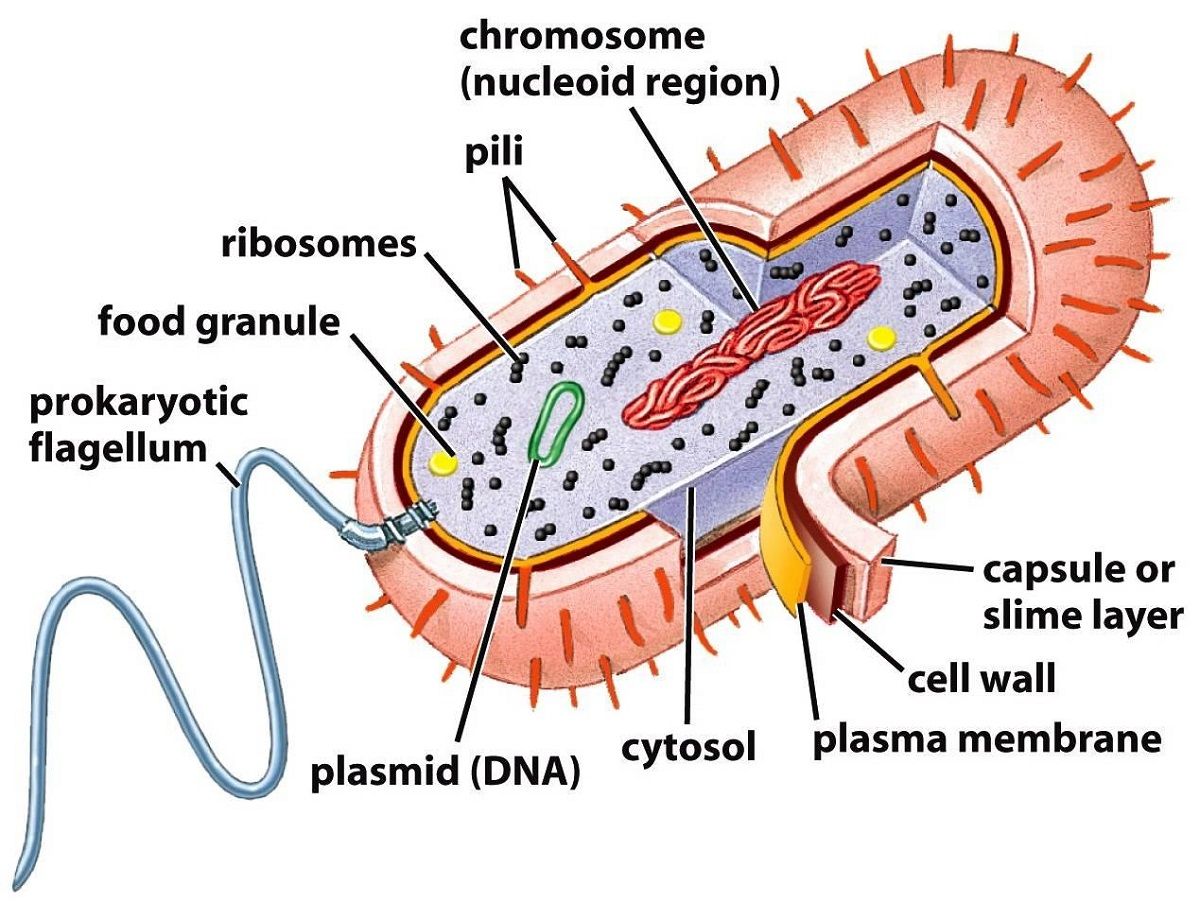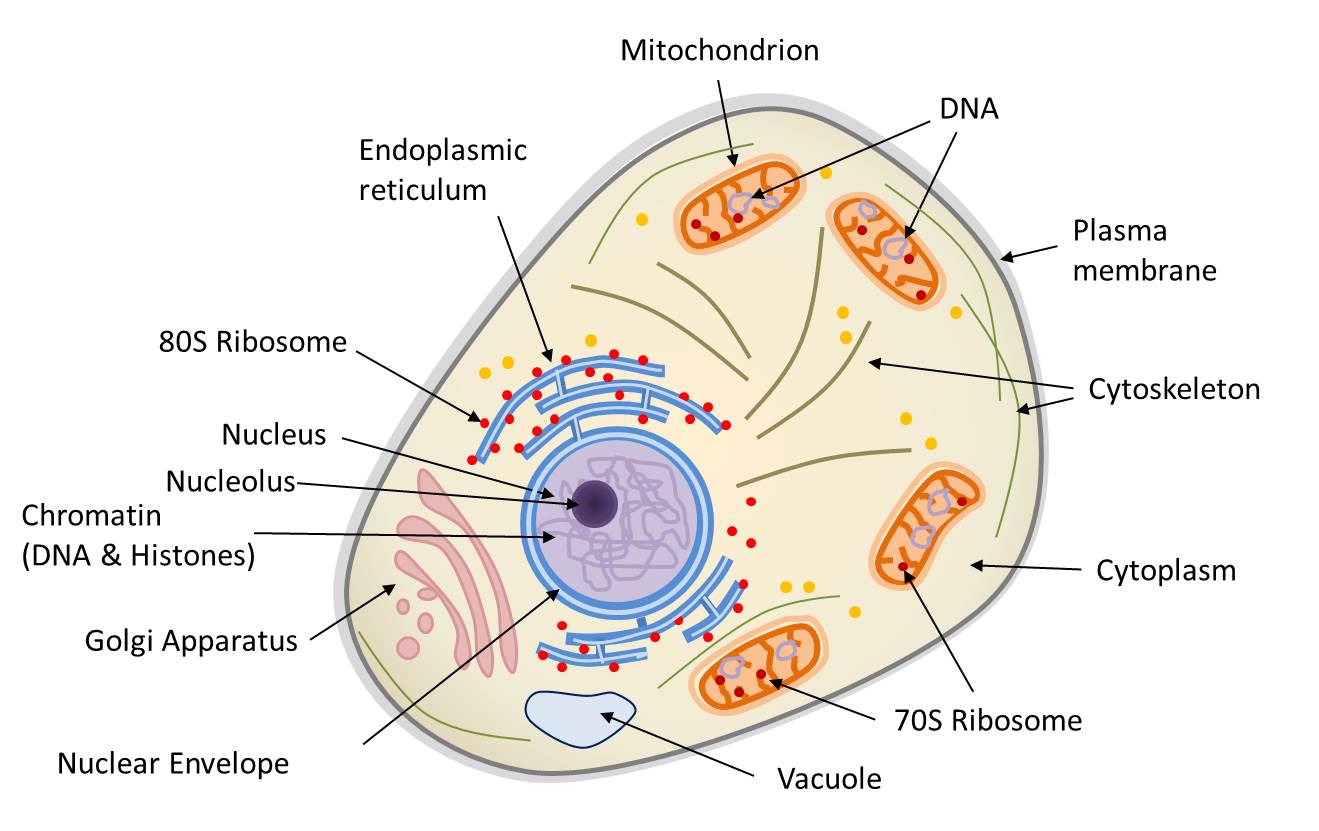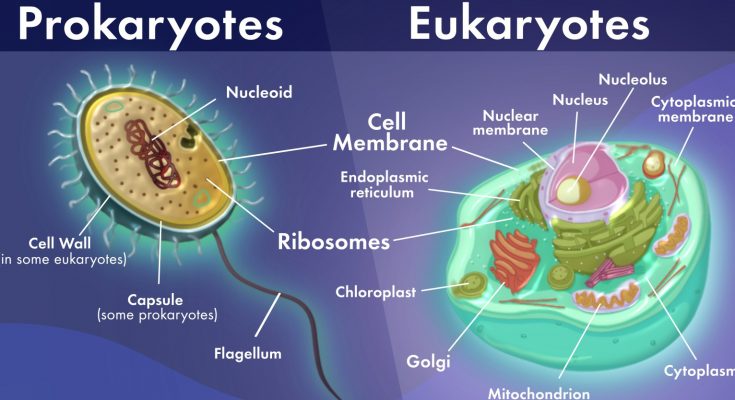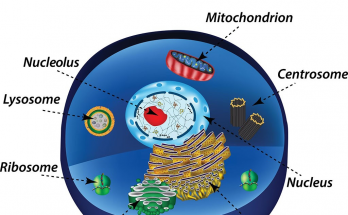Key differences between prokaryotic and eukaryotic cells include their size, complexity, and internal structures. Prokaryotic cells are smaller, simpler, and lack a nucleus, typically found in bacteria and archaea. Eukaryotic cells are larger, contain a nucleus, and have various organelles, seen in organisms like plants, animals, and fungi. The article details these distinctions, focusing on aspects such as cell wall composition, DNA arrangement, presence of organelles, and reproductive methods, to underscore the diversity and evolutionary significance of these cellular forms.
Table of Contents
15 Differences between Prokaryotic and Eukaryotic cells – Tabular Format
| Feature | Prokaryotic Cells | Eukaryotic Cells | |
|---|---|---|---|
| 1 | Cell Type | Always unicellular | Can be unicellular or multicellular |
| 2 | Cell Size | 0.2 μm – 2.0 μm in diameter | 10 μm – 100 μm in diameter |
| 3 | Cell Wall | Usually present; chemically complex | When present, chemically simpler |
| 4 | Nucleus | Absent; has nucleoid region instead | Present, enclosed by a nuclear membrane |
| 5 | Ribosomes | Smaller and spherical | Larger and linear |
| 6 | DNA Arrangement | Circular | Linear |
| 7 | Mitochondria | Absent | Present |
| 8 | Cytoplasm | Present but lacks membrane-bound organelles | Contains various membrane-bound organelles |
| 9 | Endoplasmic Reticulum | Absent | Present |
| 10 | Plasmids | Commonly present | Very rarely found |
| 11 | Lysosomes and Centrosomes | Absent | Present |
| 12 | Cell Division | Through binary fission | Through mitosis and meiosis for sexual reproduction |
| 13 | Flagella | Smaller | Larger |
| 14 | Reproduction | Asexual | Both asexual and Sexual reproduction |
| 15 | Examples | Bacteria and Archaea | Plants, animals, fungi, protists |
| Diagram |  |  |
Differences between Prokaryotic and Eukaryotic Cells – Explained in Details
1. Differences between Prokaryotic and Eukaryotic Cells in Terms of Cell Type
- Prokaryotic Cells- These cells are always unicellular, meaning each organism consists of a single cell performing all life processes. This simplicity allows prokaryotes to thrive in a wide range of environments.
- Eukaryotic Cells- Eukaryotic organisms can be either unicellular or multicellular. Multicellular eukaryotes have cells specialised for different functions, contributing to the organism’s complexity.
2.Differences between Prokaryotic and Eukaryotic Cells in Terms of Cell Size
- Prokaryotic Cells- They are typically much smaller, with diameters ranging from 0.2 μm to 2.0 μm. Their small size limits the space available for cellular components but facilitates a high surface-area-to-volume ratio, which is beneficial for nutrient uptake and waste elimination.
- Eukaryotic Cells- These cells are larger, usually between 10 μm and 100 μm in diameter, allowing for more complex structures and organelles within the cell.
3. Differences between Prokaryotic and Eukaryotic Cells in Terms of Cell Wall
- Prokaryotic Cells- The cell wall is usually present and is chemically complex, often made of peptidoglycan in bacteria, which provides structural support and protection.
- Eukaryotic Cells- When present, the cell wall is chemically simpler. For example, plant cell walls are primarily made of cellulose.
4. Differences between Prokaryotic and Eukaryotic Cells in Terms of Nucleus
- Prokaryotic Cells- Lack a true nucleus. Their genetic material is located in a region called the nucleoid, which is not enclosed by a membrane.
- Eukaryotic Cells- Have a well-defined nucleus enclosed by a nuclear membrane, separating the genetic material from the cytoplasm.
5. Differences between Prokaryotic and Eukaryotic Cells in Terms of Ribosomes
- Prokaryotic Cells- Contain smaller and spherical ribosomes, which are less complex and correspond to their simpler protein synthesis needs.
- Eukaryotic Cells- Possess larger and more complex ribosomes, reflecting their greater complexity in protein synthesis.
6. Differences between Prokaryotic and Eukaryotic Cells in Terms of DNA Arrangement
- Prokaryotic Cells- Have circular DNA, which is typically found in a single large chromosome that floats freely within the cell.
- Eukaryotic Cells- Contain linear DNA arranged in multiple chromosomes within the nucleus.
7. Differences between Prokaryotic and Eukaryotic Cells in Terms of Mitochondria
- Prokaryotic Cells- Do not have mitochondria. Their energy metabolism, such as respiration and photosynthesis, occurs across the cell membrane.
- Eukaryotic Cells- Mitochondria are present and serve as the site of aerobic respiration, producing ATP, the cell’s energy currency.
8. Differences between Prokaryotic and Eukaryotic Cells in Terms of Cytoplasm and Organelles
- Prokaryotic Cells- The cytoplasm lacks membrane-bound organelles, which limits the compartmentalization of cellular processes.
- Eukaryotic Cells- The cytoplasm contains various membrane-bound organelles, such as the Golgi apparatus, endoplasmic reticulum, and lysosomes, each with specialised functions.
9. Differences between Prokaryotic and Eukaryotic Cells in Terms of Endoplasmic Reticulum
- Prokaryotic Cells- Absent, reflecting the overall simplicity and lack of compartmentalization in prokaryotic cells.
- Eukaryotic Cells- Present, playing a key role in the synthesis, folding, modification, and transport of proteins and lipids.
10. Differences between Prokaryotic and Eukaryotic Cells in Terms of Plasmids
- Prokaryotic Cells- Often contain plasmids, which are small, circular pieces of DNA that can be exchanged between bacteria, contributing to genetic diversity and adaptability.
- Eukaryotic Cells- Plasmids are very rarely found, with some exceptions in certain fungi and protozoa.
11. Differences between Prokaryotic and Eukaryotic Cells in Terms of Lysosomes and Centrosomes
- Prokaryotic Cells– Do not have lysosomes or centrosomes. The absence of these organelles reflects the simplicity and difference in cellular processes compared to eukaryotes.
- Eukaryotic Cells- Contain lysosomes for digestion and waste processing, and centrosomes that play a role in cell division.
12. Differences between Prokaryotic and Eukaryotic Cells in Terms of Cell Division
- Prokaryotic cells– Divide through a process called binary fission, where the cell splits into two identical daughter cells.
- Eukaryotic Cells- Utilise mitosis for cell division in somatic cells and meiosis for producing gametes in sexual reproduction.
13 . Differences between Prokaryotic and Eukaryotic Cells in Terms of Flagella
- Prokaryotic Cells- Have smaller and simpler flagella, primarily used for movement.
- Eukaryotic cells– When present, flagella are larger and more complex, composed of microtubules and capable of more controlled movements.
14. Differences between Prokaryotic and Eukaryotic Cells in Terms of Reproduction
- Prokaryotic Cells- Reproduce asexually, with binary fission being the primary method. This process involves the duplication of the single circular DNA molecule, followed by the division of the cell into two identical daughter cells. Prokaryotic cells can exchange genetic material through processes like conjugation, but this does not result in the creation of new offspring.
- Eukaryotic Cells- Have the capability to reproduce both asexually and sexually. Asexual reproduction in eukaryotes often involves mitosis, where a single cell divides to produce two genetically identical daughter cells. Sexual reproduction involves meiosis, a process that reduces the chromosome number by half and results in the production of gametes (sperm and eggs). The fusion of these gametes during fertilisation creates a new organism with genetic material from both parents, increasing genetic diversity.
15. Examples
- Prokaryotic Cells- Common examples include bacteria, such as Escherichia coli and Staphylococcus aureus, and archaea, which are often found in extreme environments like hot springs and salt lakes. All members of the Kingdom Monera are prokaryotes.
- Eukaryotic Cells- Include a wide range of organisms, from single-celled protozoa and algae to complex multicellular organisms like plants, animals, and fungi. The diversity within eukaryotes is vast, reflecting the complex structure and function of these cells.
Frequently asked Question on Differences between Prokaryotic and Eukaryotic Cells
What distinguishes prokaryotic cells from eukaryotic cells in terms of cellular organisation?
- Prokaryotic cells are always unicellular and lack a nucleus, with DNA located in a nucleoid region. Eukaryotic cells can be unicellular or multicellular, with a well-defined nucleus and various membrane-bound organelles.
Compare the size of prokaryotic cells to eukaryotic cells.
- Prokaryotic cells are smaller, typically ranging from 0.2 μm to 2.0 μm in diameter. Eukaryotic cells are larger, with sizes ranging from 10 μm to 100 μm.
How do the cell walls of prokaryotic and eukaryotic cells differ?
- The cell wall in prokaryotic cells is usually present and chemically complex, often made of peptidoglycan. In eukaryotic cells, when a cell wall is present (as in plants), it is chemically simpler and made of cellulose.
Describe the nucleus in prokaryotic and eukaryotic cells.
- Prokaryotic cells lack a true nucleus; their DNA floats freely in a region called the nucleoid. Eukaryotic cells have a distinct nucleus enclosed by a nuclear membrane, housing the cell’s DNA.
Explain the difference in ribosomes between prokaryotic and eukaryotic cells.
- Prokaryotic cells contain smaller, spherical ribosomes, while eukaryotic cells have larger, more complex ribosomes, suited to their more complex protein synthesis needs.
How does the DNA arrangement in prokaryotic cells compare to that in eukaryotic cells?
- Prokaryotic cells have circular DNA located in the cytoplasm, whereas eukaryotic cells have linear DNA organised into chromosomes within the nucleus.
Are mitochondria present in prokaryotic cells?
- No, mitochondria are absent in prokaryotic cells. Their energy metabolism occurs across the cell membrane, unlike in eukaryotic cells where mitochondria are the site of aerobic respiration.
What role does the endoplasmic reticulum play in eukaryotic cells, and is it present in prokaryotic cells?
- The endoplasmic reticulum in eukaryotic cells is involved in the synthesis, folding, modification, and transport of proteins and lipids. It is absent in prokaryotic cells, reflecting their simpler structure and lack of compartmentalization.
Discuss the presence and function of plasmids in prokaryotic and eukaryotic cells.
- Plasmids, small circular pieces of DNA, are common in prokaryotic cells and contribute to genetic diversity and adaptability. They are very rarely found in eukaryotic cells, with some exceptions in fungi and protozoa.
How do prokaryotic cells divide, and how does this process differ from cell division in eukaryotic cells?
- Prokaryotic cells divide through binary fission, where the cell splits into two identical daughter cells. Eukaryotic cells utilise mitosis for somatic cell division and meiosis for gamete production in sexual reproduction.


8 Comments on “15 Key Differences Between Prokaryotic and Eukaryotic Cells”